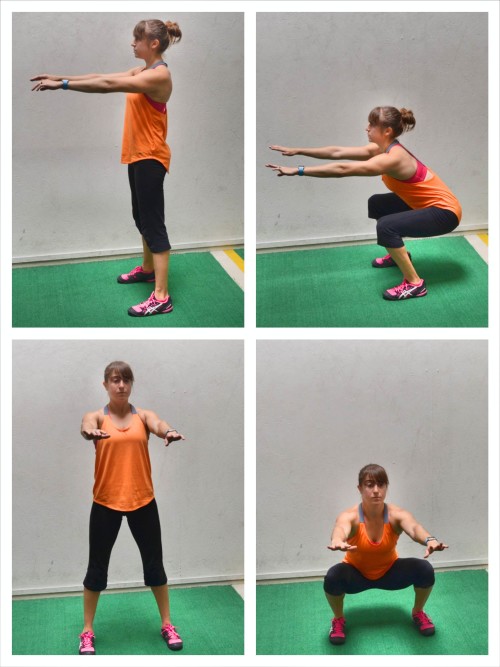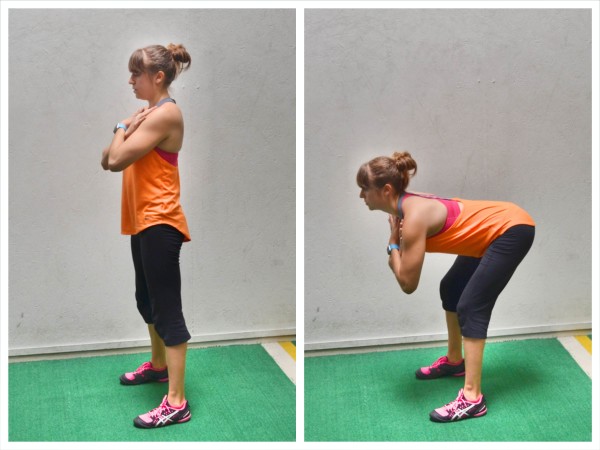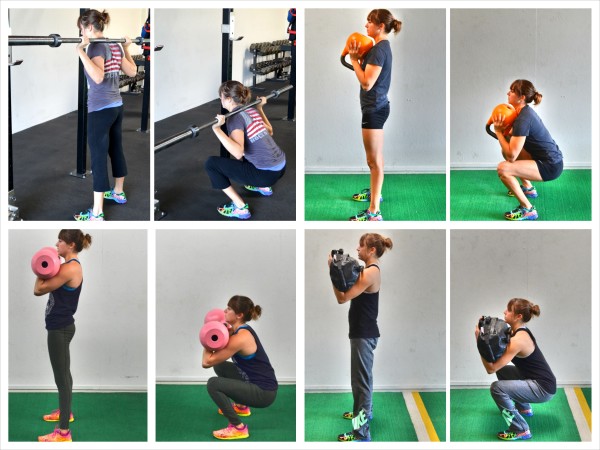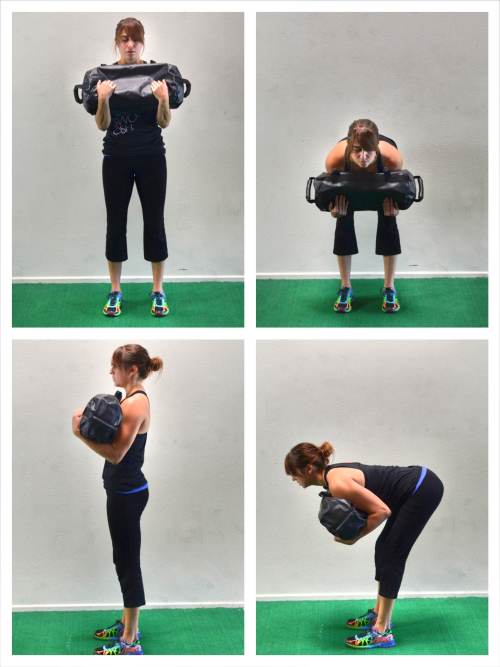Chances are you’ve heard you need to include the Squat or the Deadlift, or maybe even both, in your workout routine if you want to develop strong legs and glutes.
And both are truly great compound moves that not only strengthen your legs and glutes but also your entire core.
But what is the difference between the Squat and the Deadlift?
Should you use one over the other or can both be included in your workout routine? And if you include both when do you use them?
Squats Vs. Deadlift – What’s the Difference and Which is Better?
Let’s first review Basic Squat and Basic Deadlift form. Looking at basic form will start to highlight the differences between the two moves.
Basic Squat Form:
The most basic form of the Squat is the Bodyweight Squat. This move can be regressed by sitting down to a bench or progressed by adding weight.

To do the Bodyweight Squat, stand nice and tall with your feet about hip-width to shoulder-width apart. Your feet should be parallel and pointing straight ahead. You can place your hands across your chest on your shoulders or reach your hands out in front of you.
Then sit your butt back and down, bending at your knees as you keep your chest up. Keep your heels down as you drop your butt as close to the ground as you can.
Do not let your back round or chest fall forward as you squat. Also, make sure to keep your heels down. Only squat as low as your mobility allows.
Then drive through your heels and come back up to standing. Do not come forward onto your toes or lean forward as you stand back up. Squeeze your glutes at the top.
If your back rounds or if you shift your weight to one side or the other as you squat, do not squat as low and work on your mobility before increasing weight.
Also beware of your knees caving in or bowing out. Your hips, knees and ankles should all be in line as you squat.
If you find your squat depth is limited or your form has flaws, you will want to strengthen your glutes and improve your ankle, hip and even thoracic mobility.
Beginners may need to regress the Basic Squat further by starting with a Squat to Bench.
Advanced exercisers may load down the Basic Squat to make it harder.
NOTE: Our squats may all look slightly different without being “wrong” based on our builds and even mobility. You may have a more upright posture if you are more mobile or have a longer torso and shorter femurs vs. you may find you lean forward just a bit more if you have a shorter torso and longer femurs. The key is focusing on working with our bodies and even our current mobility restrictions as we constantly work to improve!
Basic Deadlift Form:
You can also do a Bodyweight Variation of the Deadlift. While there are a number of Deadlift Variations (check out Deadlift Variations here), for the Basic Deadlift we will review a Basic Bodyweight Hip Hinge.

To do the Bodyweight Hip Hinge, stand tall with your feet between hip-width and shoulder-width apart. Cross your arms over your chest and place your hands on your shoulders.
Then begin to hinge over at your hips, pushing your butt back toward the wall behind you as you lean forward. Keep your back flat as you hinge over and make sure to sit your butt back as you hinge.
Keep your heels down on the ground as you hinge.
Then drive up and squeeze your glutes at the top before hinging back over.
Do not let your back round. Make sure to sit your butt back as you hinge over and not simply lean forward. Also, do not be afraid to bend your knees as you hinge over.
Your legs do not need to stay straight with the Deadlift or Hip Hinge. The exactly amount of knee flexion included in your deadlift may vary based on your mobility and even the version you plan to include.
As you hinge over, do not shift your weight to one side or the other. Sit straight back.
Advanced exercisers can add weight to make the move harder.
The Difference Between The Squat And The Deadlift
Just to be clear, they may both work your legs but they are NOT the same movement. They activate and develop the muscles of our legs, back and core differently.
They are also different movement patterns, one being a knee dominant movement (the squat) vs. a hip dominant movement (the deadlift).
A simple way to think about the difference between the two is – are you sitting down or bowing?
The Squat focuses on knee bend and dropping your butt toward the ground to work your legs (aka sitting down) while the Deadilft focuses more on hinging at the hips to load the glutes and posterior chain (aka bowing).
The Deadlift is generally considered to be a more posterior chain focused movement (aka it is focused on working your backside), and, while the Squat will still work your backside, the move generally involves more quad.
More forward lean is also acceptable during the Deadlift as you are hinging at the hips while with the Squat you are trying to sit down while keeping your chest more upright.
There are, however, exceptions to these basic distinctions and even variations of both movements that really combine both and could almost even be labeled either way.
How you load down each of these moves is also generally different.
Generally with a Deadlift you hold a barbell, kettlebell, sandbag or dumbbells in your hands extended down by your sides or in front of your legs. You can even unilaterally load the move by holding a weight on one side.

Usually with a Squat the weight is placed up near your shoulders.
You can load the Squat by placing a barbell on your back behind your shoulders or you can front-load the move with the barbell in your hands at about your collarbone.
You can also front-load the squat by Racking kettlebells on your arms or by holding a kettlebell in the Goblet position. Dumbbells or sandbags can also be used to load your Squat by holding them up at your chest in your arms or over your shoulders.

So simply put – the Squat is generally loaded up around your shoulders while the weight for the deadlift is generally picked up off the ground and held down by your sides or down in front.
However, like with everything in health and fitness, nothing is black and white.
There can still be overlap between the two moves. You can hold a kettlebell down in front and Squat. You can also front-load a weight at your chest and Deadlift like in the Good Morning below.

Here the thing that distinguishes the Good Morning as a Deadlift is the fact that you are hinging at the hips and not squatting down.
A move that blurs the line between the Squat and the Deadlift is the Sumo Squat/Deadlift because it can be either based on how much hip hinge or knee flexion you use.

Basically, the Sumo Stance can be used with either movement.
With this sumo stance, you can load the weight easily as a Squat or as a Deadlift. You can make it more of a hip hinge by holding the weight down in front or you can stay up nice and tall to squat by loading the weight up at your chest.
Therefore, the Sumo stance can easily be classified under either move depending on the nuances of how it is performed.
To summarize:
- The Squat and the Deadlift are different movement patterns. One is a Squat or knee dominant movement where you bend your knees to sink your butt as close to the ground as your mobility allows while the other is a hip hinge movement not as focused on creating more knee flexion but on movement and loading occurring at the hips.
- Also, generally, the two moves are loaded different.
- However, there can be some overlap.
So Which Is Better – The Squat Or The Deadlift?
Which move is better, the Squat or the Deadlift, depends on your goals. But honestly BOTH should be included in your workout routine if you want a strong core, glutes and legs.
It isn’t bad to even have one Squat workout and one Deadlift workout each week.
Some people even put the Deadlift on their Back Workout day because deadlifts do work your back as well.
You should even vary the exact variation of each that you use based on the muscle groups you really want to target!
Want to work your core even more while still working your legs? Try a Front Squat or a Goblet Squat.
Want to work on your balance and correct imbalances while really targeting your glutes, hamstrings, core and back? Try a variation of the Single Leg Deadlift.

But what about working your glutes? Which is better?
While often the Squat is touted as the best glute move and you see photos of women with great butts all squatting, the Squat is NOT superior to the Deadlift for glute development.
Actually honestly both fall short of moves like the Hip Thruster or Glute Bridge if your focus is really on targeting your glutes.
In terms of developing your quads, you may want to focus more on including squats in your routine. While for more hamstring development, deadlifts may be better.
You may also determine which move is better based on injuries or even your mobility.
If you have knee pain, a Deadlift Variation, especially a Straight Leg Deadlift, may be better because it will not only build your backside to help prevent knee pain in the future, but it also requires less knee flexion (you don’t need to bend your knees as much).

The point is, there is no simple answer to which move is better. It all depends on your goals.
And more than likely, using BOTH movement patterns in your routine will be key!
Do you prefer the Squat or Deadlift? Do you include one or both in your routines?





Can you compare lunges to these exercise?
Yes..Depends on the lunge though. Lunges are generally more hip hinge although you’ll work more quad with front and more glutes with back or side. Plus you really want to lunge in 360 degrees!
Lunge are also great as they are a unilateral move which helps correct imbalances!
this is a really good article. great explanations. thank you!
Thanks Alex!